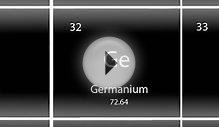A laser, which is an acronym for Light Amplification by Stimulated Emission of Radiation, is a device that converts energy into light. Electrical or optical energy is used to excite atoms or molecules, which then emit light. A laser consists of a cavity, with plane or spherical mirrors at the ends, that is filled with lasable material. This material can be excited to a semistable state by light or an electric discharge. The material can be a crystal, glass, liquid, dye, or gas as long as it can be excited in this way.
The simplest cavity has two mirrors, one that totally reflects and one that reflects between 50 and 99%. As the light bounces between these mirrors, the intensity increases. Since the laser light travels as an intense beam, the laser produces very bright light. Laser beams can also be projected over great distances, and can be focused to a very small spot.
The type of mirror determines the type of beam. A very bright, highly monochromatic (one wavelength or one color) and coherent beam is produced when one mirror transmits only 1-2% of the light. If plane mirrors are used, the beam is highly collimated (made parallel). The beam comes out near one end of the cavity when concave mirrors are used. The type of beam in the first case makes lasers very useful in medicine since these properties allow the doctor to target the desired area more accurately, avoiding damage to surrounding tissue.
A semiconductor laser converts electrical energy into light. This is made possible by using a semiconductor material, whose ability to conduct electricity is between that of conductors and insulators. By doping a semiconductor with specific amounts of impurities, the number of negatively charged electrons or positively charged holes can be changed.
Compared to other laser types, semiconductor lasers are compact, reliable and last a long time. Such lasers consist of two basic components, an optical amplifier and a resonator. The amplifier is made from a direct-bandgap semiconductor material based on either gallium arsenide (GaAs) or InP substrates. These are compounds based on the Group III and Group V elements in the periodic table. Alloys of these materials are formed onto the substrates as layered structures containing precise amounts of other materials.
The resonator continuously recirculates light through the amplifier and helps to focus it. This component usually consists of a waveguide and two plane-parallel mirrors. These mirrors are coated with a material to increase or decrease reflectivity and to improve resistance to damage from the high power densities.
The performance and cost of a semiconductor depends on its output power, brightness, and operating lifetime. Power is important because it determines the maximum throughput or feed rate of a process. High brightness, or the ability to focus laser output to a small spot, determines power efficiency. Lifetime is important because the longer a laser lasts, the less it costs to operate, which is especially critical in industrial applications.
The simplest semiconductor lasers consist of a single emitter that produces over one watt of continuous wave power. To increase power, bars and multibar modules or stacks have been developed. A bar is an array of 10 to 50 side-by-side individual semiconductor lasers integrated into a single chip and a stack is a two-dimensional array of multiple bars. Bars can produce 50 watts of output power and last over 5, 000 hours. Because such high powers produce a lot of heat, cooling systems must be incorporated into the design.
History
The concept behind lasers was first proposed by Albert Einstein, who showed that light consists of wave energies called photons. Each photon has an energy that corresponds to the frequency of the waves. The higher the frequency, the greater the energy carried by the waves. Einstein and another scientist named S. N. Bose then developed the theory behind the phenomenon of photons' tendency to travel together.
Laser action was first demonstrated in the microwave region in 1954 by Nobel Prize winner Charles Townes and his co-workers. They projected a beam of ammonia molecules through a system of focusing electrodes. When microwave power of appropriate frequency was passed through the cavity, amplification occurred and the term Microwave Amplification by Stimulated Emission of Radiation (M.A.S.E.R.) was born. The term laser was first coined in 1957 by physicist Gordon Gould.
Townes also worked with Arthur Schawlow and the two proposed the laser in 1958, receiving a patent in 1960. The first practical laser was invented that same year by a physicist named Theodore Maiman, while he was employed at Hughes Research Laboratories. This laser used a pink ruby crystal surrounded by a flash tube enclosed within a polished aluminum cylindrical cavity cooled by forced air. Two years later, a continuous lasing ruby was made by replacing the flash lamp with an arc lamp.
RELATED VIDEO


